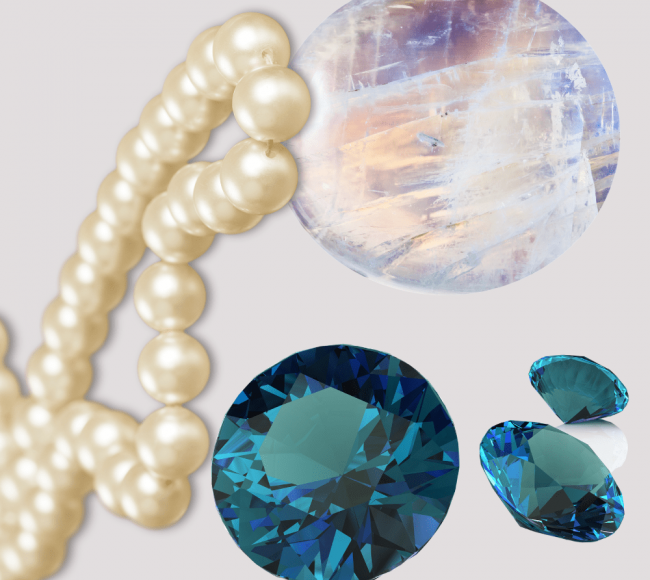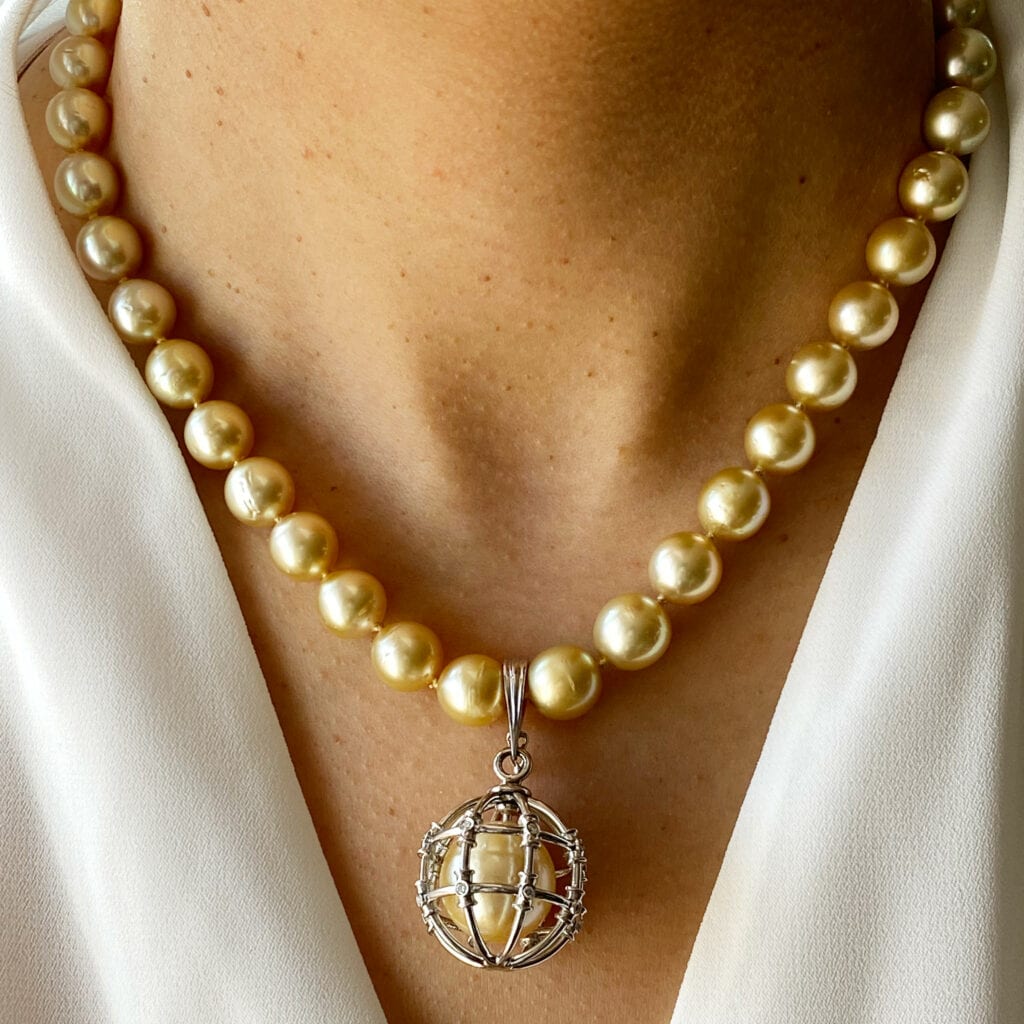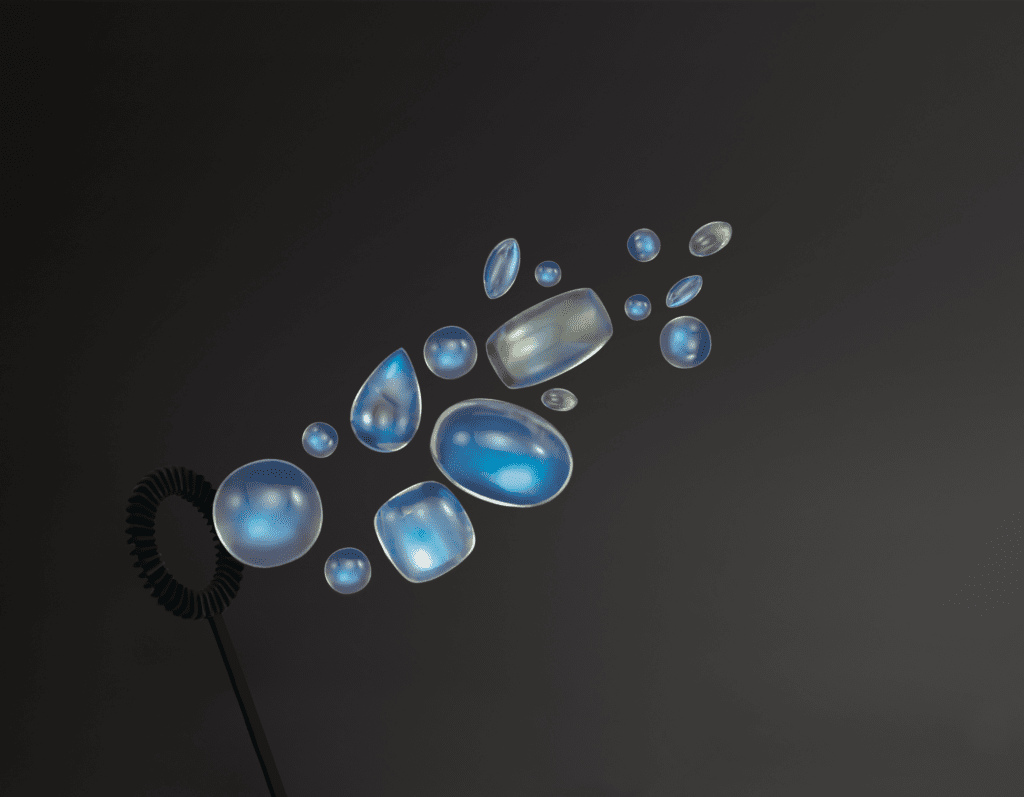
Table of Contents
Each month of the year is associated with one or multiple birthstones. June’s birthstones are pearl, alexandrite, and moonstone.
Here is everything you need to know about June’s birthstones!
The History of Pearls June Birthstones as Ancient Stones
The history of gemstones is inextricably bound with the history of humankind. Each stone has its own story, embellished throughout time by an endless succession of many cultures.
Origins of the pearl: the traditional June birthstone
Pearls are one of the oldest gemstones known to man. Ancient civilizations highly valued pearls.
The first pearls were found in China when people had mastered the art of pearl fishing. Chinese created specialized tools for diving deep into oceans to bring back large amounts of oysters with natural pearls. In Ancient Chinese culture, natural pearls symbolized purity and honesty, while in India, they represented good health and fertility.
Romans thought that pearls were tears of the gods. The Romans believed that pearl jewelry such as a string of natural pearls or an amulet with a pearl set in it was a charm to keep them safe from spells and curses. Those who navigated the Ocean would also wear pearls.
Christians adopted pearls as gemstones related to purity, chastity, and innocence. In the Middle Ages, it embodied the virtues of modesty, humility, and purity. By the 16th century, pearls were already in high demand by the French monarchy, who wore pearl-embellished crowns and other extravagant jewelry when they attended court events.

Golden South Sea Pearl Necklace with Removable Diamond Accent Cage
This luxurious golden south sea pearl necklace is perfect for making any outfit look glamorous. The 18-inch strand features a dazzling removable diamond accent cage enhancer, making it the perfect accessory for any special occasion.
The removable diamond accent cage means you can wear this necklace two different ways for multiple looks.
Where can you find pearls?
Saltwater pearls are farmed mainly in Japan, Indonesia, the Philippines, and China.
Most pearls commercially available in jewelry stores are cultured by setting a bead with a shell-less mollusk and multiple oysters together in a saltwater pearl farm. Freshwater cultured pearls mainly come from Chinese waters and the United States, especially in rivers across Tennessee where pearl farmers harvest freshwater and saltwater pearls.
Color and Appearance of Natural and Cultured Pearls
Pearl colors range from white to black and even pink, purple, gold, silver gray, blue-green, and multicolored. This wide variety of colors provides lots of options for your jewelry!
Natural pearls come as white pearls, cream/off-white, pink, peach, silver-gray pearls, gold, and even black pearls.
Cultured pearls come in various colors, including cream/off-white, gold, pink, peach, silver-gray, brown, greenish-blue. There are also rainbow freshwater cultured pearls from China with multiple layers of pigmentation, forming a unique color combination when viewed from different angles.
Pearls can be found as:
- Iridescent pearl, meaning the pearl can appear in different colors depending on the angle and light source. An iridescent pearl’s color is most apparent when the pearl is wet and shows a blotchy rainbow sheen.
- Metallic pearl gives the pearl a mirror-like shine and is more reflective than other pearls. Metallic pearls are polished with a metallic coating that can be made of gold, silver, platinum, or copper.
- Opalescent pearl, which can reflect waves of rainbow colors like an opal.
Not all cultured or natural oysters produce pearls of the same color, even within the same type of pearl (saltwater or freshwater).

Properties of Pearls
How are natural pearls created?
Mollusks produce pearls to protect themselves from irritation when grit or other foreign objects enter their shell. The mollusk’s mantle tissue creates the spherical shape of a pearl in three ways:
1. The mollusk secrets nacre, which the pearl is made out of.
2. As the mollusk secrets nacre, it wraps around the irritant in a conical shape.
3. As the irritation heightens, it requires more nacre to cover it and thus gives rise to a spherical pearl.
The outside layer of the pearl is called the periostracum or ‘skin.’ The periostracum is composed of proteins and salts that provide a protective barrier for the nacre to produce pearls.
Find out more about how pearls are made.

Scientific and Physical Properties of pearl birthstones
Pearls are composed of calcium carbonate, meaning that pearls are classified as both organic and inorganic. This organic material is the secret to pearls’ natural luster. A pearl’s nacre has a non-homogeneous structure that allows light waves traveling through it to be reflected and refracted in multiple directions, thus producing its rich and beautiful shine and iridescent colors.
The Mohs Scale is a scale that measures the hardness or scratch resistance of minerals on a scale from 1-10. Pearls have a score of 2.5-3.5, making them fragile gemstones that can be damaged very easily by harder minerals or materials.
Pearls have the same conductivity as silver, making them a good choice for those with sensitive skin.
The Rarity of Pearl, June’s Birthstone
Just like white diamonds, each pearl has its unique grading system. Pearl experts will consider size, shape, color, luster, surface quality, and overall appearance when grading pearls.
Because of the uniqueness of each pearl’s characteristics, it is difficult to determine precisely how rare pearls are. While there may be almost 10 million pearls harvested every year (this number accounts for both saltwater and freshwater), only 10% of them are considered worthy of being called “finest pearls” based on their unique characteristics.
Pearl Jewelry
Pearls are known to be a classic gemstone for jewelry because of their delicate, sophisticated beauty. Pearl jewelry such as necklaces has been a symbol of sophistication and royalty for centuries.
Mother-of-pearl is the name used to describe both the inside layer of pearl oysters as well as whole pieces of pearls that have been ground into flat pieces for use in jewelry. Mother-of-pearl is used to make pearl necklaces, earrings, bracelets, and rings.

The History of Alexandrite, June’s Birthstone
Origins of the Alexandrite: the modern June birthstone
In 1831, an unknown large green and transparent stone were found in a mine in the Ural Mountains of Russia by Italian mineralogist Count Vitali. Scientists immediately became aware of its unusual characteristics and called it “chrysoberyl cat’s eye” in reference to its chatoyancy (the reflection of a light patch along a thin surface). At the time, they believed it to be a combination of emerald and chrysoberyl.
They sent some samples to Germany for further analysis. A German mineralogist then examined them under a microscope and discovered that the mysterious green stone was an entirely new gemstone: alexandrite. Its name came from Tsar Alexander II of Russia (1818-1881).
Where can you find Alexandrite June Birthstone?
Although alexandrite is extremely rare, it can still be found today. In Russia, it is mined in the Ural Mountains. In Brazil and Sri Lanka, the color-changing gemstone can also be found, but these deposits are not as rich as those in Russia.
Color and Appearance of the Color Changing Alexandrite June Birthstone
Alexandrite is a rare gemstone with a color-changing property. Alexandrite changes color depending on the light source (natural vs. artificial) and can be reddish, purple, or green. Alexandrite owes its color-changing property to a phenomenon called pleochroism: this gemstone has very strong pleochroism, meaning that its color changes based on the angle from which it is viewed and the light source.
Alexandrite’s color is most vivid during daylight. Its color becomes a lighter greenish-yellow in the night with a brownish hue. Alexandrite can also be found in other colors, such as pink or yellow.
Here is a list of the different types of alexandrite, depending on its color hue:
– Red alexandrite.
– Pink alexandrite, which turns reddish under natural light.
– Blue or purple alexandrite.
– Green or yellowish-green alexandrite, like a fine emerald.

Properties of Alexandrite June Birthstone
Scientific and Physical Properties of Alexandrite Birthstones
Alexandrite gemstone belongs to the chrysoberyl mineral family and results from a unique mixture of two minerals: aluminum oxide and chromium oxide.
Alexandrite is 7.5-8 on the Mohs scale of hardness, which means that it can easily be scratched. Alexandrite is birefringent, which means that it has two indices of refraction: 1.7341 and 1.7618.
Alexandrite has a conchoidal or uneven fracture and an oily or greasy luster.
The Rarity of Alexandrite Birthstones
According to the Gemological Institute of America, alexandrite belongs “to the rarest gemstones that exist”.
The Alexandrite June birthstone price starts at $2,000 per carat. Opaque materials cost less than transparent ones. Alexandrite gemstones larger than 1 carat are of exceptionally high quality and command an incredibly high price.
Alexandrite is also produced in laboratories. Synthetic alexandrite is made of aluminum oxide doped with trace amounts of chromium.
Alexandrite Birthstone Jewelry
Alexandrite is associated with luxury, and, as such, it is best worn with fine jewelry pieces made from gold and platinum. Alexandrite will benefit most from rings, earrings, and necklaces that have a strong contrast.
Look for unique pieces that will enhance your stone’s bolder colors with Bling Advisor!
The History of Moonstone June Birthstone since the Ancient Times
Origins of the Birthstone Moonstone
Moonstone is one of the oldest known gemstones since back to the early civilizations of Mesopotamia. Moonstones have been found in some of the earliest civilizations, including Ancient Greece, India, Mexico, and Guatemala. The name comes from the Latin word ‘luna.’ It was believed that light reflected by the moonstone during a full moon could bring good fortune.
Ancient Greeks believed moonstone was formed from drops of moonlight falling into the sea. Greek sailors also used moonstone as a compass on their travels because its luminescence resembled the moon’s reflection.
Where can you find Birthstone Moonstone?
Moonstones are most commonly mined in Sri Lanka. However, they can also be found in India, Russia, Kenya, Madagascar, Australia, Brazil, the USA, and Canada. Native Americans have historically believed that Moonstone birthstones were formed from the rays of a full moon falling to Earth.
Color and Appearance of Moonstone June Birthstone
Moonstone comes in various colors, all with a strikingly similar appearance. They are often milky blue or silvery-white and look like opal or aquamarine.
Some moonstones exhibit a play of light known as adularescence, reflecting different colors from layers below the surface.
Here are the different types of moonstone birthstones:
– Blue moonstone is the most common type of moonstone, also known as adularescent moonstone, and can also be found in gray or colorless variations that go by the name “shield moonstone.”
– Yellow moonstone.
– Rainbow moonstone, also called labradorite, displays a play of colors similar to an opal.
– Green moonstone, which is less common than the other types.
– White moonstone (known as Rainbow Moonstone).
– Orange or peach moonstones.
– Red or orange moonstones (quite rare).

Properties of Moonstone June Birthstone
Scientific and Physical Properties of moonstone June birthstones
The June birthstone Moonstone belongs to the feldspar mineral family and is composed mainly of the mineral orthoclase.
Moonstone has a Mohs scale rating of 6.00, making it suitable for every day. However, it is not nearly as durable as quartz or diamond, which are both rated at 10 on the Mohs scale. Indeed, moonstones are somewhat brittle and can fracture with too much pressure or a strong blow.
When exposed to hot water, moonstones will soften. If held under running cold water, however, they will harden.
The rarity of moonstone June birthstones
Moonstones are not quite as rare as diamonds, sapphires, or rubies. However, their rarity still makes them costly stones to own. Their popularity has increased in recent years due to the mysterious legends surrounding this gemstone type.
The mesmerizing beauty of moonstones is beyond compare. At Bling Advisor, we have the best selection of high-quality authentic moonstone birthstones for sale. Shop now!
Moonstone Birthstone Jewelry
Bling Advisor offers an extensive collection of both natural and created moonstone June birthstone jewelry.
Moonstones are popular as earrings and necklaces, but they can also make beautiful rings if set in a suitably strong metal such as platinum or titanium.
June Birthstones Jewelry Care and Maintenance
Most gemstones require special care to maintain their beauty. The June birthstones are no exception to this rule.
We recommend that you always take off your birthstone rings or stones when using harsh chemicals as they could damage the gems’ surface. It is also advisable to remove your June birthstone jewelry before participating in strenuous activities.
You can clean these three birthstones with mild soap warm water. Avoid perfume with natural pearls as it may damage them.
When Should You Offer a June Birthstone to Someone?
There is no wrong time to give someone pearl, moonstone, and alexandrite jewelry! What better way to show your loved ones how much you care for them than by giving them a beautiful piece of June birthstone jewelry.
Choose a unique June birthstone jewelry for someone born in June or an anniversary gift.
In Summary
The June Birthstones alexandrite, pearl, and moonstone are popular choices for jewelry. They come in various colors and are both beautiful and durable high-quality stones.
Our specialists at Bling Advisor are eager to answer any questions you might have regarding those gems and jewelry. Please contact us or check our June birthstone rings and jewelry selection.
Learn more about other month’s birthstones in our blog “What Are The Birthstones by Month?“
